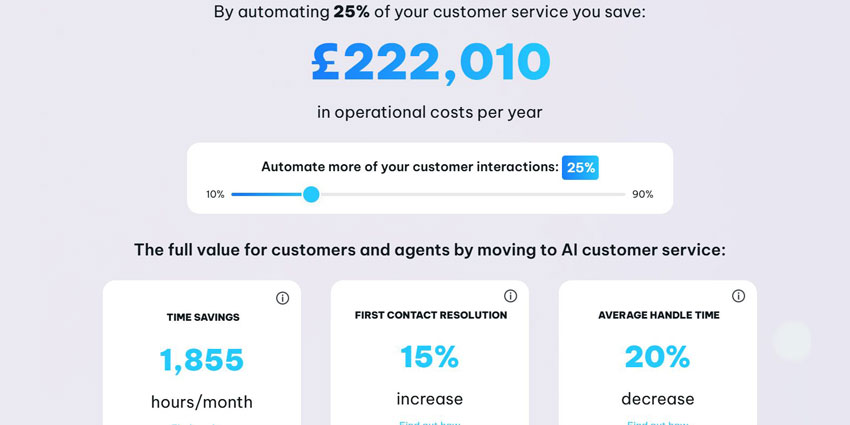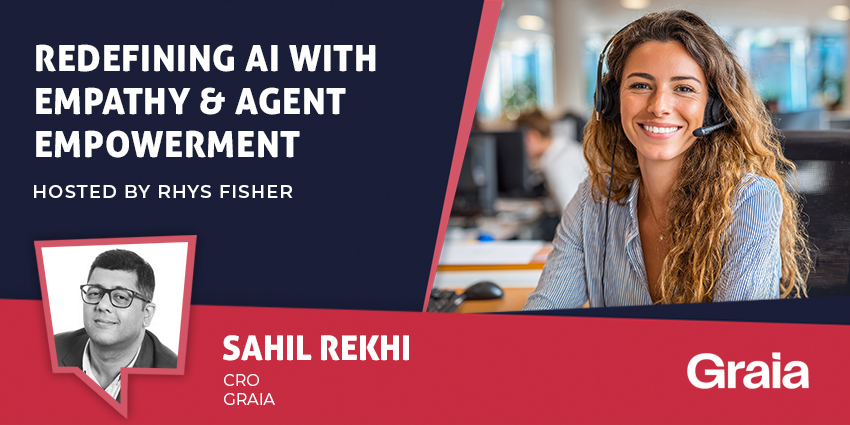NICE has released an online tool that calculates how much money and time contact centers could save with AI.
It takes minutes to run a rough calculation through the “AI Value Calculator”, with users inputting just a few key data points.
These include their location, team size, average call/chat time, call volumes, chat volumes, average wrap time, agent hourly pay, and industry.
From there, the tool allows users to set a target for the percentage of interactions they aspire to automate.
Then comes the result, which NICE notes is based on “industry averages”.
Given this, actual savings may vary significantly. Nevertheless, Stephen Davies, VP of International Marketing at NICE, believes it’s an excellent way to show contact centers what’s possible.
Announcing the AI Value Calculator launch on LinkedIn, Davies wrote:
So many CCaaS players hide behind slideware and shiny AI messaging. Time to show the market what value really looks like!
Alongside the headline price saving, the tool estimates potential time savings in hours per month.
Additionally, it offers insight into the possible impact on various customer- and employee-focused metrics. These include first contact resolution (FCR), customer satisfaction (CSAT), agent attrition, average handling time (AHT), agent satisfaction, and agent onboarding time.
Critically, NICE details exactly how it has made its forecast across each metric. However, it also stresses that contact centers can reach out to book an “in-depth” review for a more detailed and accurate projection.
NICE’s Mission: To Showcase What’s Possible Beyond Generic AI & Point Solutions
The AI Value Calculator is an excellent tool to spark conversation and engage contact center leaders.
However, it also supports NICE’s key message of showcasing what’s possible beyond the “generic AI” and point solutions.
Such solutions have risen to the fore since the AI hype cycle kicked into overdrive, post-ChatGPT-3.
Yet, according to Barry Cooper, President of NICE CX, these tools prevent contact centers from realizing the full benefits of AI.
During a recent interview with CX Today, Cooper posited that the models must be trained specifically for CX use cases.
“Take auto-summarization, for example,” he said. “Summarizing a call is a basic AI task, and while it can be done generically, a generic approach misses critical elements like industry-specific terms, customer intent, agent actions, and the final outcome. These are integral to CX.”
To Cooper’s point, CX Today recently wrote about how scaling auto-summarizations to enterprise-grade production is proving problematic for many customer service operations.
Max Ball, Principal Industry Analyst at Forrester Research, shared another example:
A company integrated a generative AI chatbot built on top of ChatGPT. However, it took over a minute and a half to generate answers—so long that the browser window timed out before responses could be delivered.
The result? A poor experience. Indeed, the company had to scrap the entire project and start over.
Yet, it’s not just generic AI; point solutions are causing trouble, too. According to Cooper, customers are overwhelmed by managing multiple AI solutions, each with its own guardrails, training models, and governance issues. They want a single place to manage AI effectively.
That led Cooper back to NICE’s heritage of consolidating multiple point solutions – including IVR, ACD, workforce engagement management (WEM), call recording, and analytics tools – on one platform: CXone.
Now, the CCaaS leader is doing the same with AI, pulling everything together with NICE Mpower.
In doing so, many industry analysts have commended its AI strategy, including Gartner in the Magic Quadrant for Contact Center as a Service (CCaaS) 2024.
With a new CEO, Scott Russell, it’ll be fascinating to see where NICE takes this strategy next.
Russell recently joined CX Today to discuss his vision for NICE in 2025 and beyond. Check out the full interview here.








